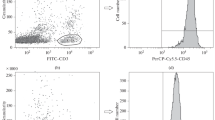Summary
Characterization of T-lymphocyte subpopulations adjacent to and infiltrating the primary tumor of breast cancer was carried out using a direct immunofluorescence procedure with the antibodies anti-(Leu-2a) for suppressor/cytotoxic (CD8+) and anti-(Leu-3a) for helper/inducer (CD4+) T-lymphocytes. Fifty-six primary malignant tumors with lymphoid infiltration were studied. The majority (58.9%) were infiltrating duct carcinoma. There were metastases to axillary lymph nodes in 6.67% of the patients. Massive lymphoid infiltration (>40 lymphocytes per ×400 microscopic field) was found in 19.6% of the tumors and moderate infiltration (20–40 lymphocytes per field) in 51.8%. In all the tumors studied there was a reversed CD4+/CD8+ ratio as compared to that found in normal peripheral blood. In 66.1% the CD4+/CD8+ ratio (helper/suppressor) was less than 1.0. The reversed ratio was due to a significant decrease in the number of helper cells (P<0.0005). The most significant drop was in the stroma area (P<0.0001) as well as in the tumor tissue (P=0.001). Of particular interest was the significant positive correlation between the age of the patients and an increased number of CD4+lymphocytes in the stroma (P=0.02). Significant negative correlations were found between a reduced number of CD4+ lymphocytes or CD4+/CD8+ ratio and several histological parameters: tumor diameter, pleomorphism, nucleus/cytoplasm ratio. There was also a significant positive correlation between the total number of CD8+ lymphocytes infiltrating the tumor tissue and the number of axillary lymph nodes with metastatic disease (P=0.03). It is suggested that the reversed ratio of CD4+/CD8+ lymphocytes may significantly affect the host/tumor immune surveillance.
Similar content being viewed by others
References
An T, Sood U, Pietruuk T, Cummings G, Hashimoto K, Crissman J (1987) In situ quantitation of inflammatory mononuclear cells in ductal infiltrating breast carcinoma. Am J Pathol 128:52
Bilik R, Mor C, Wolloch Y, Dintsman M (1986) Histopathological high risk factors influencing the prognosis of patients with early breast cancer. Am J Surg 151:460
Bloom HJ, Richardson WW, Field JR (1970) Host resistance and survival in carcinoma of breast: a study of 104 cases of medullary carcinoma in a series of 1,411 cases of breast cancer followed for 20 years. Br Med J 1:181
Cantor H, Boyse EA (1975) Functional subclasses of T-lymphocytes bearing different Ly antigens. J Exp Med 141:1376
Dillman RO, Koziol JA, Zavanelli MI, Royston I (1984) Immunoincompetence in cancer patients. Cancer 53:1484
Eilber FR, Morton DL (1970) Impaired immunologic reactivity and recurrence following cancer surgery. Cancer 25:362
Engleman EG, Benike CJ, Glickman E, Evans RL (1981) Antibodies to membrane structures that distinguish suppressor/cytotoxic and helper T lymphocyte subpopulations block the mixed leukocyte reaction in man. J Exp Med 153:193
Evans RL, Wall DW, Platsoucas CD, Siegal FP, Pikning SH, Testa CM, Good RA (1981) Thymus-dependent membrane antigens in man: inhibition of cell-mediated lympholysis by monoclonal antibodies to TH2 antigen. Proc Natl Acad Sci USA 78:544
Gottlinger HG, Rieber P, Gokel JM, Lohe KL, Riethmuller G (1985) Infiltrating mononuclear cells in human breast carcinoma: predominance of T4 monocytic cells in the tumor stroma. Int J Cancer 35:199
Grimm EA, Ramsey KM, Mazumder A, Wilson DJ, Djeu JY, Rosenberg SA (1983) Lymphokine-activated killer cell phenomenon. J Exp Med 157:884
Gross RL, Latty A, Williams EA, Newberne PM (1975) Abnormal spontaneous rosette formation and rosette inhibition in lung carcinoma. N Engl J Med 292:169
Hamlin IM (1968) Possible host resistance in carcinoma of the breast: a histological study. Br J Cancer 22:383
Kaszubowski PA, Husby G, Tung KSK, Williams RCG (1980) T-lymphocyte subpopulations in peripheral and tissues of cancer patients. Cancer Res 40:4648
Keller SE, Iochim HL, Pearse T, Siletti DM (1976) Decreased T-lymphocytes in patients with mammary cancer. Am J Clin Pathol 65:445
Morgan Da, Ruscetti FW, Gallo R (1976) Selective in vitro growth of T lymphocytes from normal human bone marrows. Science 193:1007
Morrison AS, Black MM, Lowe CR (1973) Some international differences in histology and survival in breast cancer. Int J Cancer 11:261
Nemoto T, Han T, Minowada J, Angkur V, Rao TJ (1974) Cell mediated immune status of breast cancer patients: evaluation by skin tests, lymphocyte stimulation and counts of rosette forming cells. J Natl Cancer Inst 53:641
Rosen PP, Saigo PE, Braun DW, Weathers E, DePalo A (1981) Predictors of recurrence in stage I (TlNoMo) breast carcinoma. Ann Surg 193:15
Rosenberg SA (1985) Lymphokine-activated killer cells: a new approach to immunotherapy of cancer. J Natl Cancer Inst 75:595
Rosenberg SA, Lotze MT, Muul LM, Reichert CM (1985) Observation on the systemic administration of autologous lymphokine-activated killer cells and recombinant interleukin-2 to patients with metastatic cancer. N Engl J Med 313:1487
Schroff RW, Gale RP, Fahey JL (1982) In: Vitetta E, Fox CF (eds) B and T cell tumors: biological and clinical aspects. Academic Press, New York, p 285
Schroff RW, Gottlieb MS, Prince HE, Chai LL, Fahey JL (1983) Immunological studies of homosexual men with immunodeficiency and Kaposi's sarcoma. Clin Immunol Immunopathol 27:300
Sen L, Borella L (1974) Immunological rebound after cessation of long-term chemotherapy in acute lymphocytic leukaemia: changes in distribution of T and B cell population in bone marrow and peripheral blood. Br J Haematol 27:477
Shimokawara I, Imamura M, Yamanaka N (1982) Identification of lymphocyte subpopulations in human breast cancer tissue and its significance. Cancer 49:1456
Vose BM, Moore M (1979) Suppressor cell activity of lymphocytes infiltrating human lung and breast tumors. Int J Cancer 24:579
Whiteside TL, Miescher S, Hurlimann J, Moretta L, Fliedner V (1986) Clonal analysis and in situ characterization of lymphocytes infiltrating human breast carcinomas. Cancer Immunol Immunother 23:170
Whittaker MG, Rees K, Clark CG (1971) Reduced lymphocyte transformation in breast cancer. Lancet 1:892
Author information
Authors and Affiliations
Rights and permissions
About this article
Cite this article
Bilik, R., Mor, C., Hazaz, B. et al. Characterization of T-lymphocyte subpopulations infiltrating primary breast cancer. Cancer Immunol Immunother 28, 143–147 (1989). https://doi.org/10.1007/BF00199115
Received:
Accepted:
Issue Date:
DOI: https://doi.org/10.1007/BF00199115




